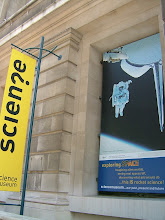The Nobel Prize in Physics 2007
Press Release
9 October 2007
The Royal Swedish Academy of Sciences has decided to award the Nobel Prize in Physics for 2007 jointly to
Albert FertUnité Mixte de Physique CNRS/THALES, Université Paris-Sud, Orsay, France,
and
Peter GrünbergForschungszentrum Jülich, Germany,"for the discovery of Giant Magnetoresistance".
Nanotechnology gives sensitive read-out heads for compact hard disks
This year's physics prize is awarded for the technology that is used to read data on hard disks. It is thanks to this technology that it has been possible to miniaturize hard disks so radically in recent years. Sensitive read-out heads are needed to be able to read data from the compact hard disks used in laptops and some music players, for instance.In 1988 the Frenchman Albert Fert and the German Peter Grünberg each independently discovered a totally new physical effect – Giant Magnetoresistance or GMR. Very weak magnetic changes give rise to major differences in electrical resistance in a GMR system. A system of this kind is the perfect tool for reading data from hard disks when information registered magnetically has to be converted to electric current. Soon researchers and engineers began work to enable use of the effect in read-out heads. In 1997 the first read-out head based on the GMR effect was launched and this soon became the standard technology. Even the most recent read-out techniques of today are further developments of GMR.A hard disk stores information, such as music, in the form of microscopically small areas magnetized in different directions. The information is retrieved by a read-out head that scans the disk and registers the magnetic changes. The smaller and more compact the hard disk, the smaller and weaker the individual magnetic areas. More sensitive read-out heads are therefore required if information has to be packed more densely on a hard disk. A read-out head based on the GMR effect can convert very small magnetic changes into differences in electrical resistance and there-fore into changes in the current emitted by the read-out head. The current is the signal from the read-out head and its different strengths represent ones and zeros.The GMR effect was discovered thanks to new techniques developed during the 1970s to produce very thin layers of different materials. If GMR is to work, structures consisting of layers that are only a few atoms thick have to be produced. For this reason GMR can also be considered one of the first real applications of the promising field of nanotechnology.
originated from: http://nobelprize.org/nobel_prizes/physics/laureates/2007/press.html
skip to main |
skip to sidebar


Cambridge University Press

Books






站在巨人的肩膀上 追尋著愛奧尼亞式迷情的源頭 找尋著存在的意義 心靈最深層的印記 烙印著傳承的使命 隨著宇宙萬物幻化 開啟不朽之殿堂

網誌存檔
Cambridge University Press

Cambridge University Press
Books

Books
Physics

British Musuem

Greenwich Observer

Science Museum

Adventurer

2008

沒有留言:
張貼留言